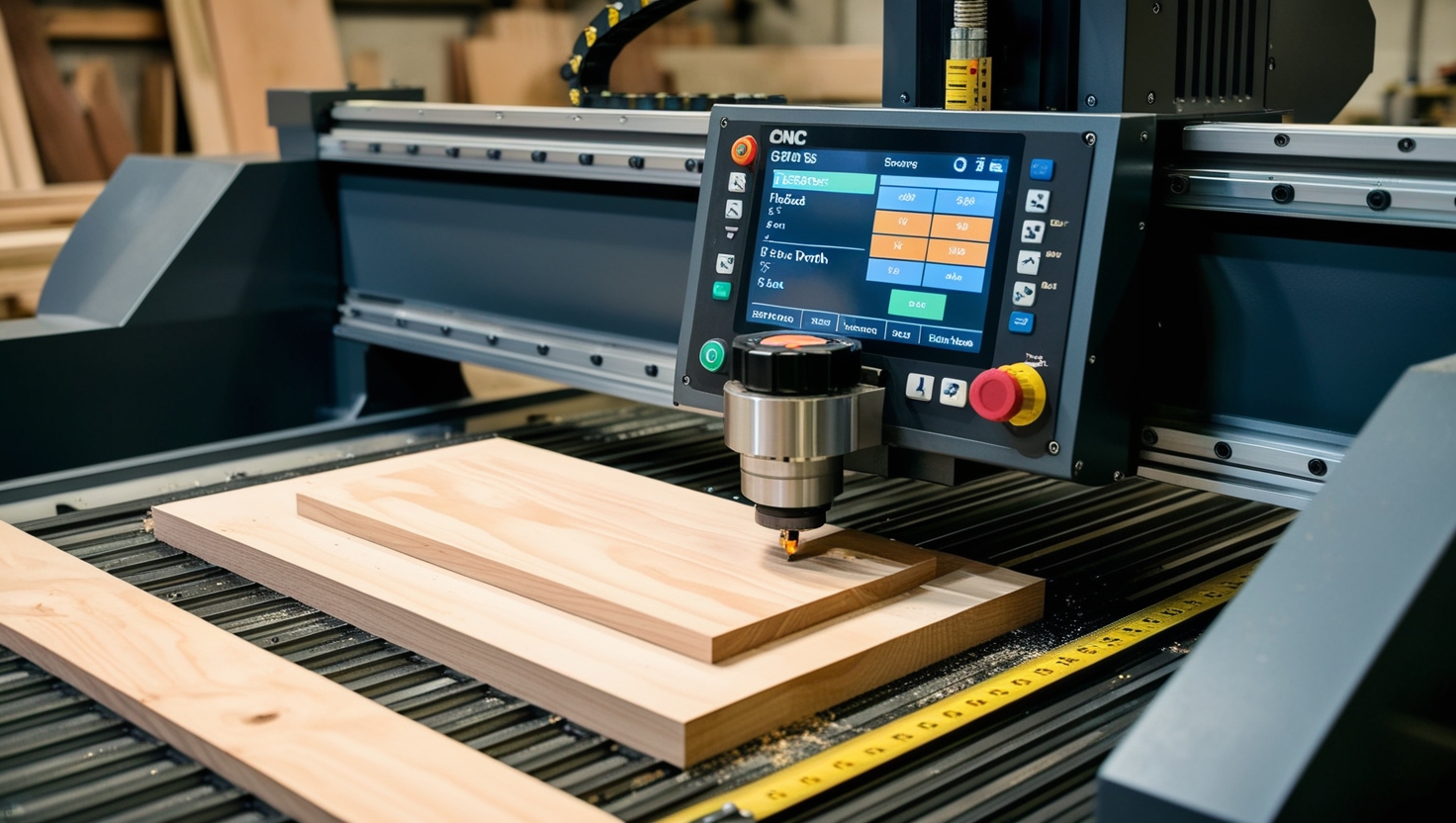Why CNC Matters
Alright, so you’re diving into the CNC world—welcome to the woodhood! CNC, aka “Computer Numerical Control,” sounds fancy, but it’s basically taking your wildest wood dreams and letting a machine do the heavy lifting. With CNC, you can carve out designs that are way too hard to pull off by hand, and it’s not just about speed. This tech lets you get those clean, precise cuts that are essential if you want your work to look pro-level. Imagine: no more shaky cuts or wonky lines; CNC is here to make sure every groove is exactly how you planned it.
CNC Hype 101
- Cuts clean and precise, every time.
- Turns digital designs into real-life wood art.
- Speeds up projects without losing quality.
Why CNC Over Hand Tools?
- Less manual labor but more control.
- Perfect for complex patterns and designs.
- Consistency: Every piece is identical if needed.
Beginner Projects with a Wow Factor
- Coasters with engraved designs.
- Custom nameplates for friends or family.
- Simple signs that show off your new skills.
What makes CNC different from your usual woodworking hustle is how it blends design with execution. With CNC, you aren’t just cutting; you’re creating and tweaking digital designs that the machine follows down to the millimeter. Think of it as turning pixels into reality! This makes CNC perfect for anyone with big ideas but little patience for endless sanding and readjusting. Once you’ve got the design down, the machine handles the details, letting you kick back and watch the magic unfold.
For beginners, CNC is like the ultimate level-up button. Sure, you’re not carving a grand dining table on day one, but with a simple CNC setup, you’re already capable of doing cool, custom pieces that wow people. Start with something small, like a personalized coaster or a nameplate, and watch as you get comfortable with the tech. Trust me—every beginner project is a stepping stone to some next-level creations. With CNC, you’re officially in the big leagues; time to make something awesome!
Understanding Your Wood Laser Cutter
Here’s the deal: not all wood is created equal. Every piece of wood has its own “personality,” and knowing the difference between softwoods, hardwoods, and even exotic types is crucial. Softwoods like pine are more forgiving, which makes them a go-to choice for newbs. Hardwoods, on the other hand, are dense, durable, and add a high-end feel to your projects, but they’re tougher to cut. Exotic woods? Those are for when you’re really feeling yourself. Get to know these types, and you’ll soon pick the perfect wood every time, like a real pro.
Softwoods vs. Hardwoods
- Softwoods like pine: easier to cut, beginner-friendly.
- Hardwoods like oak: durable but tougher to work with.
- Choose based on your project’s needs and your skill level.
Spotting Quality Wood
- Look for straight, flat boards.
- Avoid wood with large knots or cracks.
- Check for consistency in grain and color.
Understanding Wood Grain
- Fine grain: good for smooth finishes.
- Bold grain: adds texture and character.
- Grain direction affects how easy it is to cut and sand.
Picking the right piece of wood is kinda like choosing a dance partner. You want something that won’t give you trouble mid-cut, which means no major knots, cracks, or bends. Look for pieces that are straight, flat, and clean because these will save you endless headaches. The best pieces are smooth and ready to roll with the CNC machine, giving you that primo finish without the hassle. Trust, you’ll thank yourself later when you’re not wrestling with the wood just to get a decent cut.
Essential CNC Tools
Let’s talk tools—the real stars of your CNC setup. Your router bits are like the paintbrushes for your wood canvas, and each shape does something different. End mills give you smooth, straight cuts, ball noses add rounded edges, and V-bits? They’re perfect for engraving details that pop. You don’t need to own every bit under the sun, but a handful of versatile bits will take you from newbie to CNC whiz in no time.
Router Bit Basics
- End mills for straight cuts.
- V-bits for engraving detail.
- Ball nose bits for rounded edges.
Clamping Essentials
- Use clamps to hold wood firmly in place.
- Different clamps for different wood sizes.
- Avoid movement for clean cuts.
Safety First
- Wear goggles to protect your eyes.
- Use a dust mask to avoid inhaling sawdust.
- Consider a dust collector for a cleaner workspace.
Next up, clamping. Seriously, nothing ruins a project faster than a piece that slides mid-cut. Clamps keep that wood locked down tight, so your machine can cut with precision and avoid mishaps. A loose piece of wood can turn a promising project into kindling, so make sure you’re equipped with a variety of clamps to hold every project size. Mastering clamping techniques is a total game-changer for your CNC experience.
Intro to CAD Design
Time to get digital! CNC is all about turning your ideas into files that the machine can read. That’s where CAD (Computer-Aided Design) comes in. Think of it like a digital sketchbook where you can play around with shapes, sizes, and even colors. This is the first step to bringing your concept to life, and while CAD can sound intimidating, beginner-friendly software makes it easy to get started. Draw it up, tweak it, and you’re halfway to masterpiece status.
Intro to CAD Software
- CAD makes designing easy, even for beginners.
- Programs like Easel and Fusion 360 are beginner-friendly.
- You can draw, adjust, and perfect designs digitally.
Creating Machine-Ready Files
- Export your CAD file in G-code format.
- This code guides the CNC machine’s movements.
- Make sure settings match your project needs.
Simulation Station
- Run a virtual test of your design.
- Helps catch mistakes before they happen.
- Gives you a preview of the final outcome.
Next, you’ll need to transform that digital design into a file format the CNC machine can understand, usually G-code. It sounds techy, but the software does most of the heavy lifting here. All you have to do is export the file from your CAD program and feed it to the CNC machine. You’re basically setting the machine’s roadmap, so it knows exactly where to cut and how deep to go. Follow the steps, and you’ll be ready to roll.
Getting Your CNC and Wood Ready to Go
Before you fire up that CNC, it’s crucial to understand your machine. Each wood laser cutter setup has unique speeds, feeds, and settings, so knowing your machine’s quirks is essential for getting those crisp cuts. Some machines are speedy but sacrifice precision, while others prioritize smoothness over speed. Get familiar with your CNC’s personality, and you’ll be able to set it up right every time.
Know Your Machine’s Limits
- Learn the speeds your machine can handle.
- Know the maximum depth it can cut.
- Each CNC machine has unique settings.
Align Your Wood Perfectly
- Ensure the piece is straight and centered.
- Measure twice to avoid mistakes.
- Use a test alignment before starting the actual cut.
Test Cuts Are Your Friend
- Do a quick trial cut on scrap wood.
- Helps confirm your design and settings.
- Reduces the risk of ruining your main piece.
Once you’re dialed in, the next step is prepping your wood. Precision is key here, so make sure your measurements are spot-on and that your piece is perfectly aligned. A quick way to mess up a cut is to have your wood set at an angle or off-center. Take the time to align everything, measure twice (seriously!), and make sure your wood is clamped tight. This setup will save you endless headaches down the line.
Your First CNC Woodcutting Project
Alright, it’s go time! For your first project, keep it simple—try something like a keychain, a sign, or a coaster. These projects are straightforward but give you a feel for how the CNC operates and let you experiment with different cutting techniques. Start with these small wins; they’ll give you confidence for bigger projects down the road.
Starter Project Ideas
- Engraved keychains for practice.
- Small signs with your name or motto.
- Coasters with personalized designs.
Different Cutting Techniques
- Engraving for surface designs.
- Pocketing for recessed areas.
- Through-cuts to create full shapes.
Depth Adjustments
- Shallow cuts for light details.
- Medium depth for a bold look.
- Deep cuts for strong contrast and layers.
When you’re cutting, you’ve got options: engraving, pocketing, or through-cuts. Engraving is perfect for adding custom details, pocketing is for creating recesses, and through-cuts are for full shapes and outlines. Each method brings out a different vibe, so mix it up and try a bit of everything. This way, you’ll learn how each type of cut looks and feels in the finished product.
Common CNC Mistakes
Look, everyone hits a bump in the road, especially when learning CNC. Bit breakage, for instance, is super common for beginners. It happens when you push the bit too hard or fast. Avoid this by easing into your cuts; you’re better off taking it slow and steady. Broken bits are annoying and can get pricey, so treat them with care, and you’ll get more out of them.
Bit Breakage Prevention
- Go slow and steady with each cut.
- Don’t push the bit too hard.
- Replace bits before they get dull.
Toolpath Troubleshooting
- Double-check file settings before cutting.
- Calibrate your CNC machine.
- Ensure toolpaths are aligned with your design.
Stay Calm and Correct the Course
- Use each mistake as a learning moment.
- Every error teaches you more about CNC.
- Make adjustments and try again confidently.
Another common rookie mistake is the dreaded toolpath terror: you set up the file wrong, and now the machine’s off-course. Misalignments happen to everyone, but double-checking your settings can save you big time. Get in the habit of rechecking your files and calibrating your CNC, especially before detailed cuts. A little prep can stop a disaster before it starts.
Finishing Laser Techniques
After all that cutting, it’s time to bring your work to life with some finishing touches. Start with sanding. This step takes your project from rough to refined, giving the wood a soft, smooth feel. Sanding might feel like extra work, but it’s essential for that pro look and feel. You’ll thank yourself later when your wood looks polished and clean.
| Finishing Step | Description | Tools Needed | Pro Tip |
| Sanding | Smooth out rough edges and surfaces for a polished look. | Sandpaper, sanding block, or orbital sander | Start with coarse grit and work up to fine for best results. |
| Staining | Adds color and enhances the wood grain’s natural look. | Stain, brush, or cloth | Test stain on a scrap piece to check color before applying. |
| Sealing | Protects wood from moisture and damage over time. | Sealer or polyurethane, brush | Apply thin coats, letting each dry fully before the next. |
| Final Touch | Give it a shine and show it off! | Polishing cloth or buffer | A light polish makes your project photo-ready! |
Now, it’s time to stain! Staining is where you can get creative with colors and tones, bringing out the natural grain or adding a unique twist. Whether you’re going for a deep mahogany or a light oak, stain adds personality. Just make sure to test it on scrap wood first; you don’t want any color surprises!
Seal it up! A finishing seal protects your masterpiece from wear, moisture, and damage, keeping it looking fresh for years. Once sealed, step back, take a photo, and show off your hard work. You’ve officially turned raw wood into a wow-worthy project!




